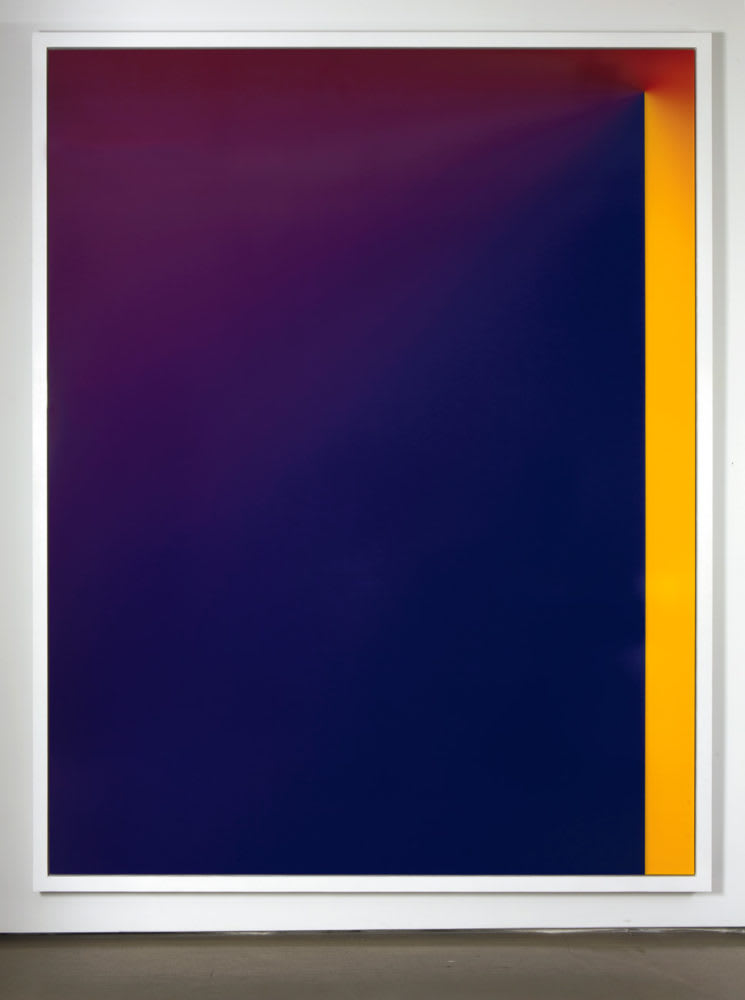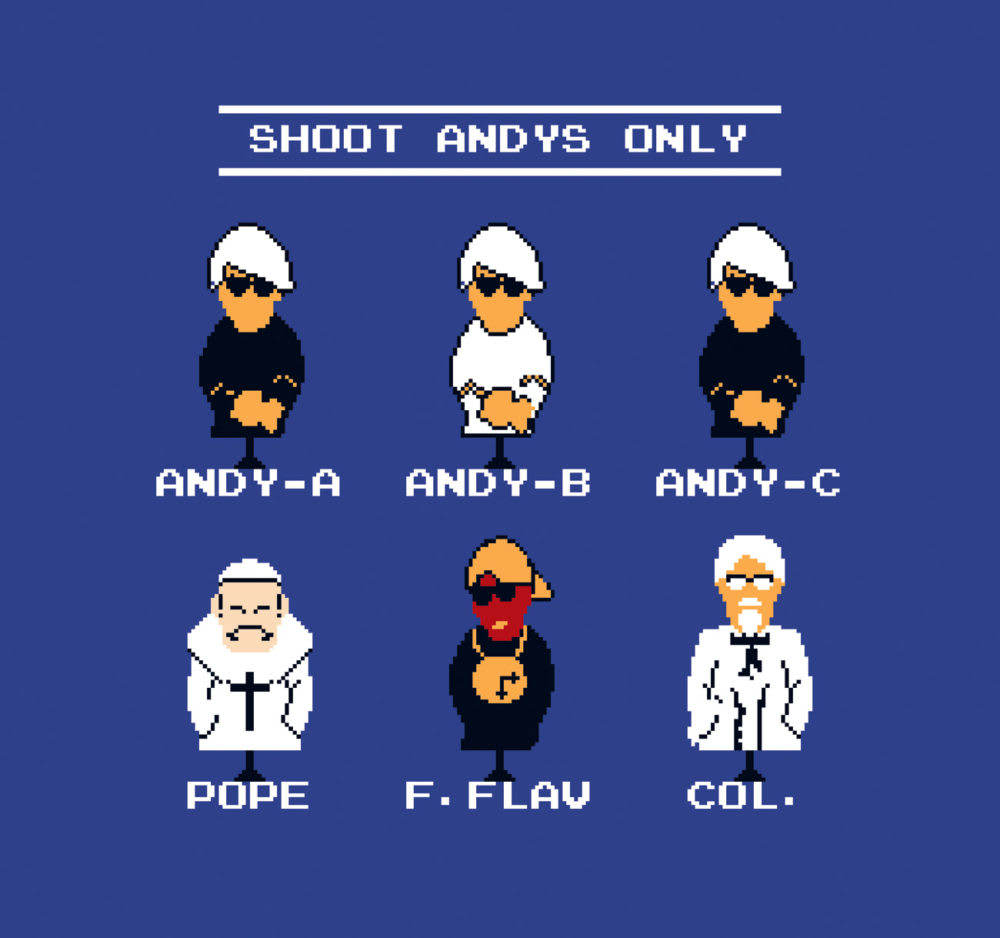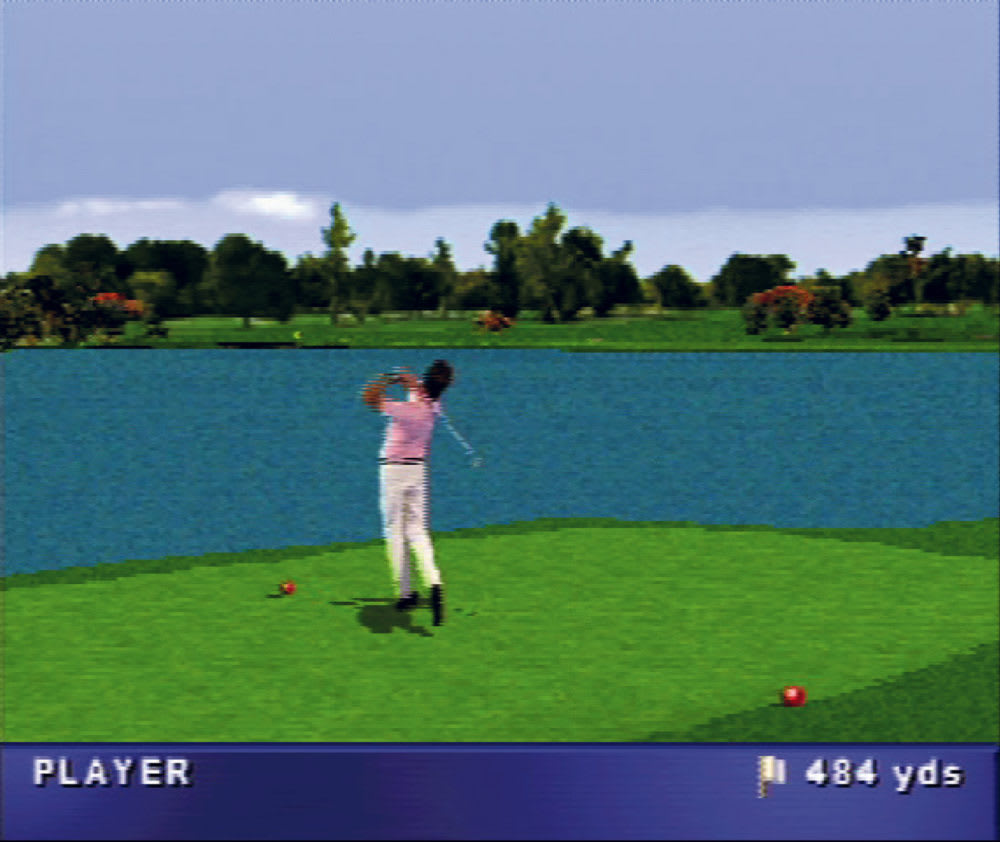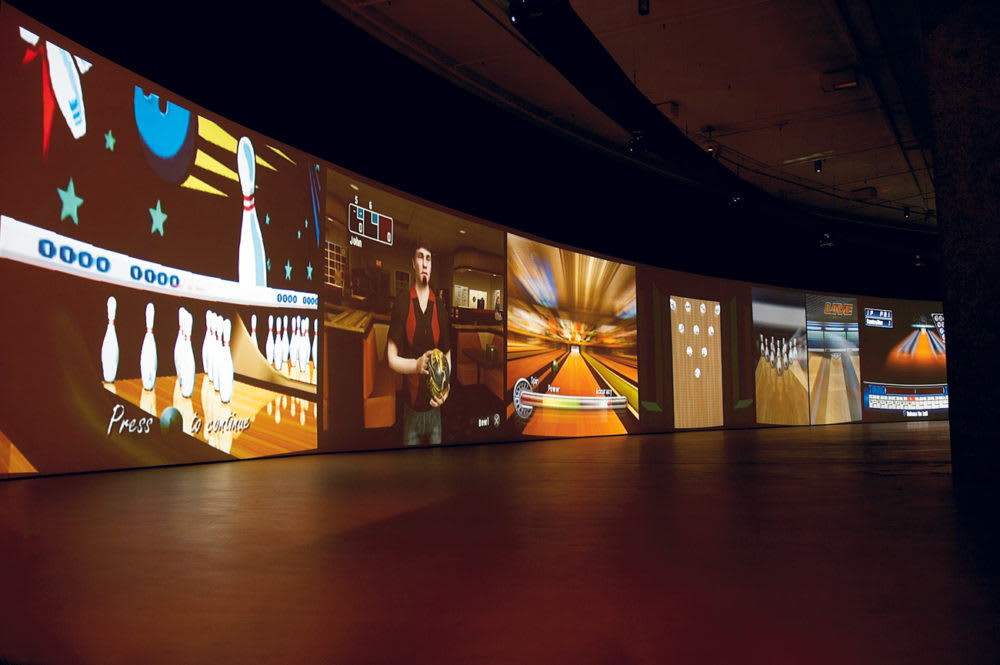
Cory Arcangel

I think to be an artist, on one side, you have to be a space cadet. Then on the other side, you’re basically running a small business, so you have to somehow muster the brainpower against your own instincts.
Cory Arcangel
For anyone who was born before 1970, the emergence of the video-game aesthetic in contemporary art might seem like an affront akin to a hack. But for a generation that essentially evolved from birth alongside their Ataris, Commodores, ColecoVisions, and Nintendos, the crude digital landscapes, bleeping primary-colored graphics, and foreshortened three-dimensionality of computer-generated worlds have been burned in the memory perhaps as deeply as the layout of a childhood house. Thirty-two-year-old artist Cory Arcangel is one of the principal artists bringing a tech nerd’s love of gaming and programming into the gallery. In one sense, Arcangel is clearly overthrowing tradition with his pop-futuristic approach to painting—one that embraces Photoshop over oils, Mario Bros.’s backgrounds over pastoral realism, and screens over canvases. But at the same time, the Buffalo, New York, native continually exploits obsolete systems and games, offering a sense of nostalgia and pop-cultural graveyard-digging for the once beloved, now prehistoric technologies.
A classically trained guitarist at Ohio’s Oberlin Conservatory of Music, Arcangel switched over to newer media out of an interest in experimental music and visual art. It wasn’t long before he put a hacker’s spin on his productions, creating a number of works that manipulated and modifiedprograms—whether deleting certain elements to focus on individual graphics or reworking the entire code tocreate a new scenario. In part it sometimes seems as if his art is culling and commenting on technology—andindividual attempts to personalize it—as fast as it’s being developed. For Super Mario Clouds, a series he began in 2002, Arcangel invaded the iconic Nintendo game and removed all graphics except for the scrolling background clouds set against a blue sky. In another landscape work, 2004’s F1 Racer Mod, the artist left only a central two-lane road forever drifting into a mountain horizon. For 2002’s I Shot Andy Warhol, Arcangel raided the 1980s shooting game Hogan’s Alley and replaced its targets with pop figures such as the Pope, Colonel Sanders, Flavor Flav, and, of course, Warhol himself. Arcangel’s practice expands beyond the realm of video games—recent projects have involved collecting clichéd blog messages,creating a cat-on-piano rendition of an Arnold Schoenberg work from found YouTube videos, and playing the glockenspiel in a live performance to accompany Bruce Springsteen’s Born to Run.
Next month Arcangel will unveil his own show at New York’s Whitney Museum of American Art. Entitled “Cory Arcangel: Pro Tools,” the exhibition will include projections of bowling video games in chronological order from the 1970s to the aughts; in effect, the entire evolution of gaming can be witnessed, and Arcangel has hacked the code so they only throw gutter balls. Another game piece invites viewers to swing a club for a virtual modified golf game—golf being an artificial reality created to mimic nature to begin with. Arcangel also plans on devoting room to his Photoshop gradient paintings. Arcangel recently sat down with his friend, painter Mary Heilmann, at her downtown Manhattan studio to discuss how a kid who didn’t play many games on the computer became the man who turned software tricks into an art.
MARY HEILMANN: When I was preparing for this interview I made a little file—my Cory file.
CORY ARCANGEL: I’m sure I’d be horrified to see what’s in it.
HEILMANN: What game did the clouds come from?
ARCANGEL: Super Mario Bros.
HEILMANN: I wonder if the designers who did Super Mario Bros. looked at Georgia O’Keeffe. [laughs]
ARCANGEL: I feel like it’s possible. Those games aren’t art objects, but they came out of culture. I always assumed those graphics were influenced by pop art. At least that was always my interest in those graphics. They are so simple. I thought, Oh, I could put this in a gallery and people would probably think it was art.
HEILMANN: And you’ve been using Photoshop to make your Color-Field works. It’s very basic Photoshop, right?
ARCANGEL: Just one click. If you have Photoshop I could show you. [At Heilmann’s computer] You open it up and there’s this paint bucket. If you click and hold it you get the gradient tool. Then you click up here and get to pick these different options. You drag it and it goes like this! That’s how you make them.
HEILMANN: When do you call up Larry Gagosian?
ARCANGEL: Well, when I’m done I print them out. The printing is important because it’s very high-end. It’s printed on photographic paper and it’s exposed to a laser. That’s how most photographers print their work now. They don’t do darkroom stuff. It’s all digital.
HEILMANN: Do you consider these works paintings?
ARCANGEL: People keep coming at me with the question, is it a painting or is it a photograph? Technically it’s a photograph. It’s a photograph because it’s photographic paper. But obviously I think about them as paintings, because they refer to the history of painting, right? I also have to think about them as sculptures, because every part of the process is part of the project. They’re sculptures because they play on the idea of what should be hanging in a gallery. In that sense they’re also kind of ready-mades.
HEILMANN: I always think of my paintings as sculptures. Are these works multiples or one of a kind?
HEILMANN: I see the image of a little kitty cat walking up and down the piano and we’re gonna hear Schoenberg. You did the mixing of that, right?
ARCANGEL: Yes. I went through the score of the opera. I had hundreds of cats on pianos downloaded, so if the score called for an E note, I would go through my cat files and find a cat that was standing on the E note. I spent about six months! It’s all three movements, and it’s about 16 minutes. I first showed it a bit too early because a curator came to my studio and I was talking about it. He wanted it for his show. It was in Austria, and I flew out for the opening and did a little folk music performance at the opening. The funny thing is, I’m really good at playing guitar but I had never played and sung at the same time before. It was really difficult.
HEILMANN: But I bet the audience liked it anyway.
ARCANGEL: Yes, I can charm my way out of a situation when I screw up.
HEILMANN: When you were a kid, did you play a lot of video games?
ARCANGEL: I never was much of a game player, but I loved to be on the computer.
HEILMANN: What kind of computer did you have back then?
ARCANGEL: I had an Apple IIGS, which stood for graphics and sound. It was the mid-’80s. When I was born we had a Commodore 64. But I really grew up with Apples. Let’s get some residuals on that mention. [laughs] But my Commodore still works. I haven’t tried my Apple IIGS. You know what’s scary? When I moved to New York in 2000 and started paying attention to this kind of stuff, these computers were on eBay for $20. Now they’ve started to become collector’s items.
HEILMANN: They’re antiques.
ARCANGEL: It’s probably also because people my age are entering their mid-thirties and they’re basically starting to collect things that they grew up with.
HEILMANN: I love your clouds.
ARCANGEL: Thank you. Luckily it’s still one of my favorite things. Sometimes things you make fall out of favor.
HEILMANN: You get over them, in a way.
ARCANGEL: I did the clouds purposely slow and clunky. They don’t move very fast. I made this in 2002 but I had the idea a year or two before.
HEILMANN: Was this your first animation?
ARCANGEL: No. I had done previous, similar animations on the Nintendo before. Also, even before I knew how to do something like this, I was just cutting and pasting graphics from video games and making little animations or cartoons. I was making animations in different ways on my computer ever since I can remember.
HEILMANN: So as soon as computers could do it, you could do it. The boy and the computer are developing at the same time, in a way.
ARCANGEL: Yeah, literally. That’s a great way to put it. The computers were new and I was new. I think the first big game was in the late ’70s. I remember going to my friend’s house, because my family never had a Nintendo, and my friend would never let me play his. I remember just sitting on his bed watching him play for hours. That’s how I kind of got interested in it. My real experience with video games was watching other people play. That’s why a lot of my work isn’t really about playing. It’s about watching video games.
HEILMANN: It’s not interactive.
ARCANGEL: One of my pieces for the Whitney in May is 14 video games. When you go into the gallery there are 14 projections next to each other, and they’re all showing bowling video games. They stretch from the beginning of bowling video games, which is 1977, all the way to the recent bowling games of the 2000s. You can see the progression. And I modified all of them so you can’t play them and they only throw gutter balls. All of them are gutter balls over and over and over again.
HEILMANN: Each one is on a loop, right?
ARCANGEL: I’ve actually made a system that plays the game in real time so the game thinks somebody is pressing the buttons, but it’s just another little robot.
HEILMANN: So are any of these guys suing you for nicking their games
ARCANGEL: [laughs] No, no, no. I’ve never had that problem, for whatever reason. Obviously there is fair use. But for this piece you get to see a 30-year progression of video games.
HEILMANN: They’ve been doing bowling video games since the beginning.
ARCANGEL: Yeah. In the late ’70s it was just this little white ball going up.
HEILMANN: Like Pong?
ARCANGEL: Very similar to Pong, because that was before they had any kind of three-dimensional space.
HEILMANN: If there’s going to be sound with each of these works, it will be one huge racket.
ARCANGEL: Yes, there will be. A big noise fest.
HEILMANN: Okay, I was trying to figure out if you were dyslexic or anything, which a lot of kids are these days. I’ve noticed that you forget names.
ARCANGEL: I’m absolutely terrible. I see a face and I’ll know I know somebody, but I will have absolutely no idea . . .
HEILMANN: I wonder if it’s a function of a certain kind of thinking. People used to call it absent-minded.
ARCANGEL: Or being a space cadet. I’ve always been like that. But it’s funny, I think to be an artist, on one side, you have to be a space cadet. Then on the other side, you’re basically running a small business, so you have to somehow muster the brainpower against your own instincts.
HEILMANN: But, of course, now you have a computer where you can find out all of the information that you forgot.
ARCANGEL: Usually when I try to find something on my computer, it’s a laborious task of, where did I put that? Or where is that e-mail? I never know where things are. It’s started to spiral out of control lately.
HEILMANN: You might need some people to come in and do that for you.
ARCANGEL: Actually when I get back I’m meeting with somebody who’s going to help me with a FileMaker Pro database.
HEILMANN: What else will be at the Whitney? ARCANGEL: I’m making a massive kinetic sculpture. I’ve been making sculptures out of these bizarre rotating stands lately. It’s all been a process of me getting away from video. Once I did those kinetic sculptures I slowly decided that I wanted to be a real artist that makes–
HEILMANN: Three-dimensional objects.
ARCANGEL: Yes. You can buy these rotating stands from China. They are fairly common for stores to use if they want to spruce up their display windows. But I’ve been using them in different ways. In one work, the motors are slightly out of sync, so you can see the two sculptures slowly fall out of phase.
HEILMANN: I was looking for your Bruce Springsteen video [Bruce Springsteen Born to Run Addendum, 2006] on your site yesterday, but I couldn’t find it.
ARCANGEL: I have to reorganize my website. I organize it by year because I want the years to compete against each other. It’s 2011 now and I want to make better work in 2011 than I did in 2010. That’s why everything is organized chronologically. I’m afraid if I organize it in a way that actually makes sense for other people, I’ll lose my sense of trying to always be better. HEILMANN: It’s competition.
ARCANGEL: Competition against myself. Like golf.
HEILMANN: You got into social networking just as it started to become a real force. Like Facebook.
ARCANGEL: Absolutely. I like to try all that stuff out. I like to go on different social networks and search for different phrases. One of them is “Follow my other Twitter.” It’s kind of an inside joke about social networks. People often have two identities and they’re always asking people to follow the other one. Another phrase I like to search for is “Working on my novel.” These people are broadcasting the fact that they’re working on their novels, which obviously they are not because if they were working on their novels they wouldn’t be spending their time telling people. So these archives are little jokes about the situations that people get themselves into when they enter these new worlds of communication on their computers. Because computers make people go a little crazy, you know? Here is another one: “Sorry I haven’t posted.” This is a collection of posts of people writing about the different reasons that they haven’t posted. It’s actually a blog that I’ve started. The best one is a guy who wrote “I had a heart attack.” And this other person has had the same headache for a week straight, so that I can understand not posting.
HEILMANN: Will these be presented as artwork?
ARCANGEL: Well, that’s a really good question.
HEILMANN: Could you ever?
ARCANGEL: I would present it as an artwork that exists on the Internet, but not in a gallery. And maybe as a book one day—so it is an artwork.
HEILMANN: What about as a movie? That’d be hot!
ARCANGEL: That’s a good idea. It’s part of my art practice, but a lot of my art practice doesn’t ever make it to the gallery. So I have a different audience.
HEILMANN: I hope you are being reimbursed for all your various production costs!
ARCANGEL: That I do keep track of. But it’s new to me, and, like I said before, I’m a bit of a space cadet.
HEILMANN: You know the guy I learned all about computers from was one of the guys at MIT who invented a lot of this stuff. The whole rest of his life was chaotic. He never paid his taxes, didn’t pay his mortgage, had to move out of his apartment . . .
ARCANGEL: It’s related. Somehow when you get into something, everything else has to go out the window.
HEILMANN: It’s a certain kind of focus and intelligence, too.
ARCANGEL: I would argue that a lot of MIT guys who were computing at that time were doing a wildly creative endeavor. They were making things up. Engineering is a creative practice. I can imagine that they were all total personal disasters to put that much focus into scientific and creative things.
HEILMANN: Well, Ted Kaczynski [the Unabomber] was a computer genius at Berkeley.
ARCANGEL: Hey, did you hear the new Lil Wayne lyrics? We should look it up. This is something crazy! It’s something like, “Real Gs move in silence like lasagna!” Total genius. Unimaginable.
HEILMANN: Did you get Jay-Z’s book?
ARCANGEL: Yeah! It’s very similar. He goes through his songs and explains the plays on words and the references and it’s really fascinating.
HEILMANN: Almost all the language in thinking and writing is oral.
ARCANGEL: Neither Lil Wayne or Jay-Z write down their lyrics. Lil Wayne said in a documentary he doesn’t write down lyrics because he believes it constrains his creativity.
HEILMANN: Is he the one who loves Justin Bieber?
ARCANGEL: [laughs] I think a lot of them love Justin Bieber. At this point, most people love Justin Bieber. What a life. Can you imagine the lives of these people? It’s so different. Art is so slow. Well, art is fast, but with art you’re tied down. That’s too negative. What I mean is, you have a business and a place that you go every day. I guess some artists do move around.
HEILMANN: And the fame. You cannot get that famous as an artist.
ARCANGEL: That’s true. It’s just not possible. Maybe Warhol was that famous. Did you ever meet Andy Warhol?
HEILMANN: I saw him. I saw him across the room.
ARCANGEL: That probably counts.

Photoshop CS: 84 by 66 Inches, 300 dpi, RGB, square pixels, default gradient “spectrum,” mousedown y=22100 x=14050, mouseup y=19700 x=1800, 2010, Unique C-print (from The Series Photoshop Gradient Demonstrations 2008–).


Two keystoned projectors (one upside down), two projectors and a VCR, dimensions variable, 2007.

I Shot Andy Warhol, video still, 2002

Not yet titled golf mod, video still, 2011

Super Mario Clouds v2k3, modified Nintendo game system, video still, 2002.

Video painting, single channel video still, 2008.

Installation shots of Arcangel’s Various Self Playing Bowling Games, 2011, detail, courtesy of the artist, Lisson Gallery, Team Gallery, and Galerie Thaddaeus Ropac. All installation shots courtesy of Eliot Wyman and Barbican Art Gallery. Retouching: Chris Ferretti. Grooming: Anthony Turner/Art Partner, using Aveda Men including pure-formance grooming cream. Set Design: Piers Hanmer/Art + Commerce. Stylist Assistant: Elin Svahn. Special Thanks: Milk Studios.